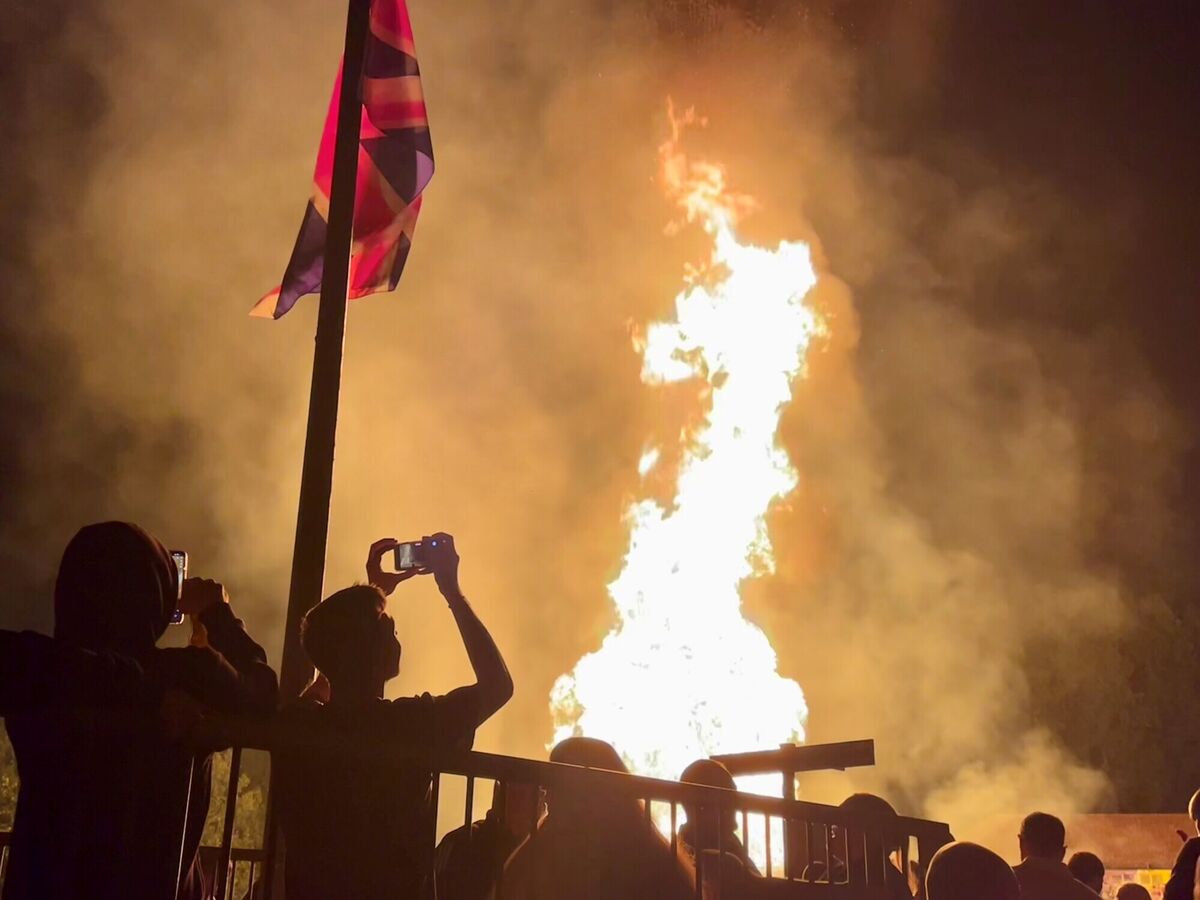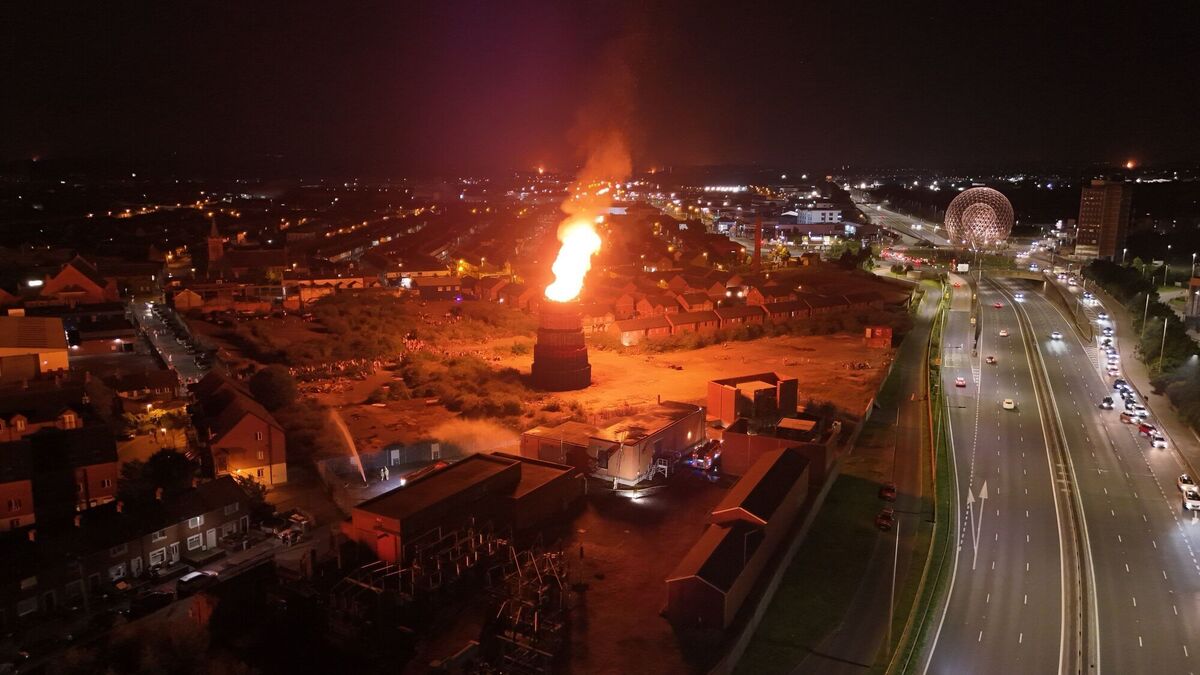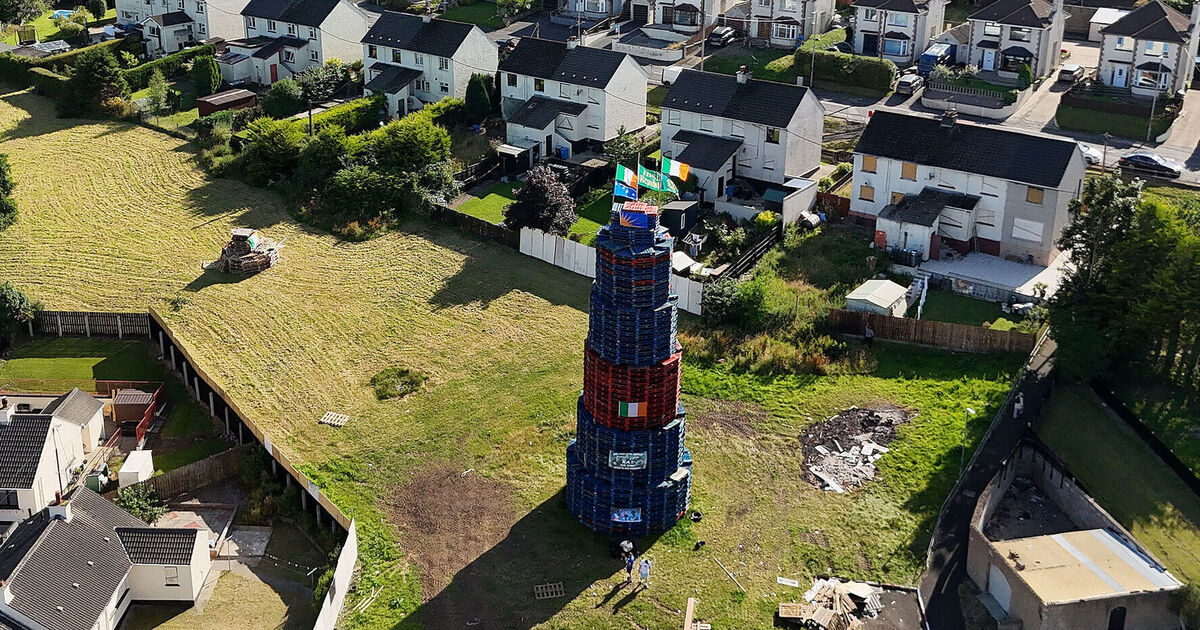Every July, towering stacks of pallets, tyres, and waste materials appear overnight across parts of Northern Ireland as monuments not for celebration, but towards division. These are the Eleventh Night bonfires, lit by loyalist communities on the eve of July 12 to mark the victory of William of Orange at the Battle of the Boyne. For others in the North, however, they represent a provocative display of sectarianism, often accompanied by effigies, flags, and symbols intended to intimidate.
Beyond their political symbolism, the environmental toll of these bonfires is immense, and growing. Beneath the flickering flames lies a deeper, smouldering issue: air pollution, toxic emissions, and damage to land and water. In the face of climate change and public health challenges, questions are being raised, not just about what these bonfires stand for, but what they’re doing to the environment we all share.
 An Eleventh Night bonfire in Orangefield Park in east Belfast. Some of the largest structures stand more than 30 feet tall and are constructed from tens of thousands of wooden pallets, along with tyres, plastics, furniture, and household waste. These materials, when set alight, release a potent and dangerous cocktail of pollutants into the air.
An Eleventh Night bonfire in Orangefield Park in east Belfast. Some of the largest structures stand more than 30 feet tall and are constructed from tens of thousands of wooden pallets, along with tyres, plastics, furniture, and household waste. These materials, when set alight, release a potent and dangerous cocktail of pollutants into the air.
Smoke signals
While often described by organisers as cultural or community events, the scale of Eleventh Night bonfires reveals a more troubling picture. Some of the largest structures stand more than 30 feet tall and are constructed from tens of thousands of wooden pallets, along with tyres, plastics, furniture, and household waste. These materials, when set alight, release a potent and dangerous cocktail of pollutants into the air.
Among the most harmful are particulate matter (PM2.5 and PM10). These are microscopic particles that can penetrate deep into the lungs and bloodstream, triggering respiratory and cardiovascular problems. Levels of these particles can spike dramatically during bonfire night, with air quality monitors in Belfast and Derry recording pollution levels comparable to those in industrial cities during smog events. For those with asthma, or heart conditions, the health risks are immediate and severe.
The burn-off also includes dioxins, benzene, carbon monoxide, and polycyclic aromatic hydrocarbons (PAHs), many of which are carcinogenic. These chemicals don’t just disappear with the smoke; they settle in soil, seep into waterways, and linger in the air. The environmental impact, though less visible than the flames, is far more enduring.
Tyres, plastics, and the law
Despite regulations prohibiting the burning of tyres and many synthetic materials, such items continue to be a staple of many bonfires. Tyres, in particular, are a serious environmental hazard. When combusted, they emit heavy metals, volatile organic compounds, and fine particulates that are hazardous to both human and ecological health.
In theory, burning such materials is illegal under Northern Ireland’s environmental laws. In practice, enforcement is weak. Councils often fund clean-ups after bonfires, some of which are built on public land, but rarely intervene in the build-up or construction stages. This tacit tolerance fuels a cycle of impunity, with local authorities caught between environmental responsibility and political sensitivities.
Land and water contamination
Once the flames die down, scorched plots of land are left behind, often heavily contaminated. Rainfall following bonfires can wash ash, chemicals, and microplastics into local rivers, drains, and soil. This runoff threatens aquatic life, degrades biodiversity, and risks entering drinking water systems.
 Firefighters work to protect an electricity sub station as a Controversial bonfire at Meridi Street, off the Donegall Road in Belfast is lit. Picture: Niall Carson/PA Wire
Firefighters work to protect an electricity sub station as a Controversial bonfire at Meridi Street, off the Donegall Road in Belfast is lit. Picture: Niall Carson/PA Wire
In some cases, bonfires have been built close to schools, housing estates, and even gas tanks, raising concerns not only about pollution but about public safety. The cost of restoring damaged land, including removing burnt debris and remediating soil, falls largely on local councils, and by extension, the taxpayer. In 2022 alone, Belfast City Council reportedly spent more than £100,000 on bonfire-related clean-up and security measures.
Cultural tradition or environmental risk?
For those who build and attend them, Eleventh Night bonfires are seen as expressions of unionist history and identity. But for others, the bonfires represent an outdated and dangerous tradition.
It’s worth noting that not all bonfires are equal. Some communities have made efforts in recent years to build safer, more environmentally responsible structures, using only untreated wood, excluding tyres and plastic, and even incorporating LED-light “beacon” bonfires as symbolic alternatives. These initiatives show that cultural expression does not have to come at the cost of environmental degradation, but such examples remain the exception.
The political nature of the bonfires, combined with the fear of stoking tensions, has made open criticism difficult. Yet, in an era of climate emergency, the question must be asked, how long can we continue to burn tens of thousands of tonnes of waste each year, unchecked, in the name of tradition?
Environmental justice
There is also a broader environmental justice issue at play. The most toxic bonfires are often located in working-class areas, those same communities already disproportionately affected by air pollution, limited access to green space, and poor health outcomes. This means the people most exposed to the environmental fallout of bonfires are often the least resourced to deal with its consequences.
In this context, rethinking bonfire culture isn’t simply an environment matter — it’s about equity. If councils, environmental agencies, and community leaders work together, it may be possible to chart a different course.
Lighting a better path
As the flames fade and the ash settles, we are left with a choice. We can continue to allow toxic bonfires to blaze unchecked, or we can begin the difficult, necessary conversation about changing the way we mark this time of year. Cultural traditions evolve. They always have. The question is whether we have the courage, and the foresight, to evolve with them.
Until then, Northern Ireland’s skies will keep filling with smoke each July, but so too will its rivers, its soil, and its lungs.
